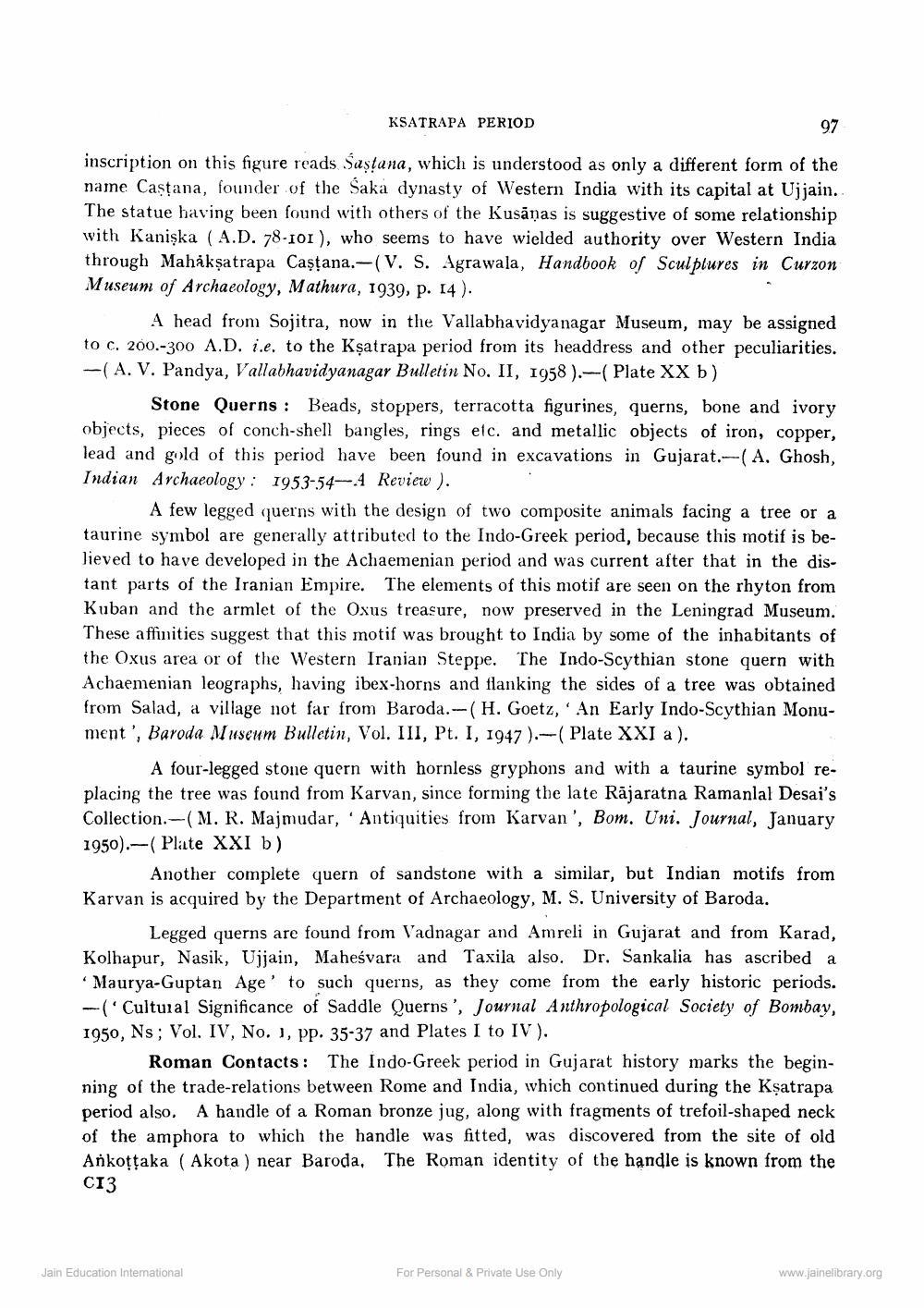________________
KSATRAPA PERIOD
97
inscription on this figure reads Sastana, which is understood as only a different form of the name Castana, founder of the Saka dynasty of Western India with its capital at Ujjain. The statue having been found with others of the Kusānas is suggestive of some relationship with Kaniska (A.D. 78-101 ), who seems to have wielded authority over Western India through Mahåksatrapa Caştana.-(V. S. Agrawala, Handbook of Sculplures in Curzon Museum of Archaeology, Mathura, 1939, p. 14).
A head from Sojitra, now in the Vallabhavidyanagar Museum, may be assigned to c. 200.-300 A.D. i.e. to the Kşatrapa period from its headdress and other peculiarities. -(A. V. Pandya, Vallabhavidyanagar Bulletin No. II, 1958).-( Plate XX b)
Stone Querns : Beads, stoppers, terracotta figurines, querns, bone and ivory objects, pieces of conch-shell bangles, rings etc. and metallic objects of iron, copper, lead and gold of this period have been found in excavations in Gujarat.-(A. Ghosh, Indian Archaeology : 1953-54-4 Review ).
A few legged querns with the design of two composite animals facing a tree or a taurine symbol are generally attributed to the Indo-Greek period, because this motif is believed to have developed in the Achaemenian period and was current after that in the distant parts of the Iranian Empire. The elements of this motif are seen on the rhyton from Kuban and the armlet of the Oxus treasure, now preserved in the Leningrad Museum. These affinities suggest that this motif was brought to India by some of the inhabitants of the Oxus area or of the Western Iranian Steppe. The Indo-Scythian stone quern with Achaemenian leographs, having ibex-horns and flanking the sides of a tree was obtained from Salad, a village not far from Baroda.-(H. Goetz, ' An Early Indo-Scythian Monument', Baroda Museum Bulletin, Vol. III, Pt. I, 1947).- Plate XXI a).
A four-legged stone quern with hornless gryphons and with a taurine symbol replacing the tree was found from Karvan, since forming the late Rājaratna Ramanlal Desai's Collection.-(M. R. Majmudar, ' Antiquities from Karvan', Bom. Uni. Journal, January 1950).-( Plate XXI b)
Another complete quern of sandstone with a similar, but Indian motifs from Karvan is acquired by the Department of Archaeology, M. S. University of Baroda.
Legged querns are found from Vadnagar and Amreli in Gujarat and from Karad, Kolhapur, Nasik, Ujjain, Maheśvara and Taxila also. Dr. Sankalia has ascribed a * Maurya-Guptan Age' to such querns, as they come from the early historic periods. --('Cultural Significance of Saddle Querns', Journal Anthropological Society of Bombay, 1950, Ns; Vol. IV, No. 1, pp. 35-37 and Plates I to IV).
Roman Contacts: The Indo-Greek period in Gujarat history marks the beginning of the trade-relations between Rome and India, which continued during the Kşatrapa period also. A handle of a Roman bronze jug, along with fragments of trefoil-shaped neck of the amphora to which the handle was fitted, was discovered from the site of old Ankoțţaka ( Akota ) near Baroda. The Roman identity of the handle is known from the CI3
Jain Education Intemational
For Personal & Private Use Only
www.jainelibrary.org




